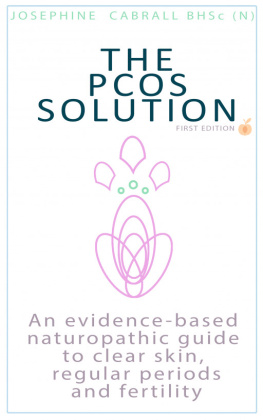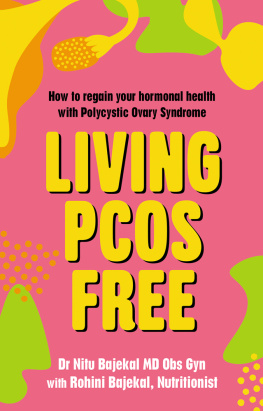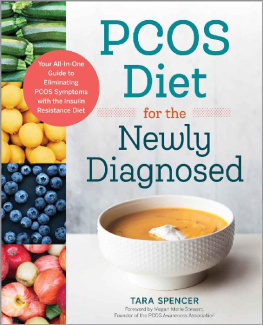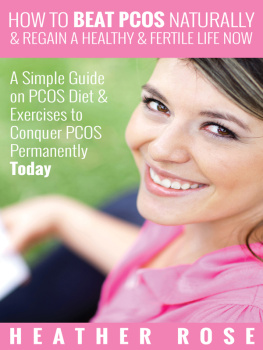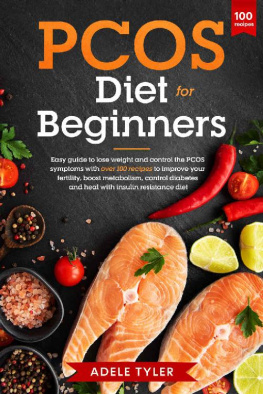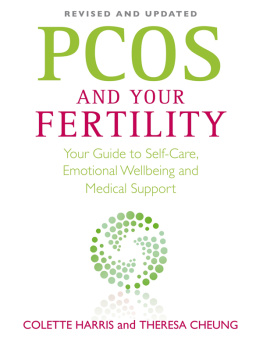The PCOS Solution
Your guide to clear skin,
regular periods
and fertility
By Josephine Cabrall
Edited by Jessica Lloyd
Illustrations by Jessica Thomas
Copyright 2017 JosephineCabrall
Smashwords Edition, License notes:
This ebook is licensed for your personal enjoymentonly. This ebook may not be re-sold or given away to other people.If you would like to share this book with another person, pleasepurchase an additional copy for each recipient. If youre readingthis book and did not purchase it, or it was not purchased for youruse only, then please return to your favorite ebook retailer andpurchase your own copy. Thank you for respecting the hard work ofthis author.
Chapter 1 PCOS Explained
Somethings not right
Being diagnosed with polycystic ovariansyndrome (PCOS) can be confusing you may have been told itsabout cysts, excess male hormones or a lack of ovulation. All youreally know is that somethings not right.
It might be showing up as acne that persistswell beyond your teenage years, facial hair growth, irregularperiods, weight gain, or maybe youve decided its time to have ababy and the pregnancy test is negative month after month.
In the medical world, there is no cure forPCOS. The solutions presented are drugs that control the symptoms(until you stop taking them) or drugs that help you to conceive,while the underlying problem remains.
But there is another choice treat the underlying cause. You can change the hormonal imbalancethat underlies PCOS. You can have clear skin, regular periods and be fertile,without drugs. This book is your guide to doing justthat.
What is PCOS?
Fundamentally, PCOS is a hormonal imbalance that leads to theoverproduction of male hormones androgens.
Androgens are called male hormones becausethey are a group of hormones responsible for the stimulation ofmale characteristics such as beards and baldness. Women normallyproduce androgens from the ovaries and adrenal glands in smallamounts, which is healthy and necessary for libido, motivation andprevention of bone loss. In PCOS, androgen production isincreased.
If there are too many androgens in a woman,they find their way to her pores, stimulating oil production, acne,dandruff, hair loss and coarse hair growth on the face, belly,chest or back.
Androgens can also interfere with ovulation(the release of an egg from your ovaries), make your periodirregular, and because of those things, make it difficult to fallpregnant.
But I thought PCOS was caused by cysts?
With PCOS, your ovarieswill often have a bumpy, cystic appearance when you have a scan.This is how PCOS originally got its name:
poly (many)
cystic (cysts)
ovarian (ovaries)
syndrome
But guess what? The cysts are actuallyimmature follicles little blister-like structures on your ovariescontaining eggs. Women normally have a number of developingfollicles on their ovaries at any one time, but when there are morethan 12 immature follicles per ovary, they are termed polycysticovaries.

Polycystic ovaries are one of the hallmarksof PCOS and are what often shows up during a scan, but confusingly,you neednt have polycystic ovaries on your scan to be diagnosedwith the syndrome. So really the name polycystic ovarian syndromeis a little misleading and the syndrome should probably be calledsomething else.
Two of the three criteria below are enoughfor a diagnosis of PCOS:
+ Infrequent or absent menstrual periods
+ Signs and symptoms of excess androgens(male-pattern hair growth, acne, hair loss, high androgens on ablood test)
+ The appearance of more than 12 cysts onboth ovaries under ultrasound.
Signs and symptoms ofPCOS
PCOS is not a disease. Itsa syndrome, which means a set of signs andsymptoms that are related to each other .This is why the experience of having PCOS is different foreveryone.
A sign is something we can see, and asymptom is something you can feel. Below is a full list of signsand symptoms related to PCOS. Remember, you dont have to have allthe symptoms to be diagnosed with the syndrome.
+ Infrequent periods periods are 35 daysor more apart
+ Absent periods no period for threemonths or longer
+ Irregular cycle length the lengthbetween periods varies by eight days or more each cycle
+ Hirsutism (male-pattern hair growth) onthe chest, back, chin, upper lip, abdomen, upper arms, innerthighs and pubic region
+ Hair loss thinning hair or male-patternhair loss
+ Dandruff
+ Acne and oily skin
+ Anxiety, stress, depression
+ Sugar cravings
+ Difficulty losing weight
+ Acanthosis nigricans (skin pigmentation) areas of thicker, darker skin with a velvety texture that tend tooccur in body folds such as the neck, underarm and groin
+ Infertility caused by infrequentovulation
+ Severe premenstrual syndrome (PMS)
+ Ovaries that have a cystic appearance whenviewed via ultrasound (12 or more immature follicles on eachovary)
Long-term risks of PCOS
PCOS can lead to other, more seriousconditions if left untreated, such as diabetes, obesity, heartdisease and certain cancers. You may have already experienced someof these.
What has gone wrong with mybody?
To understand what has gone wrong with ourhormones in PCOS we first need to understand how a menstrual cyclenormally occurs and what hormones govern this.
A normal menstrualcycle
The menstrual cycle is the series of eventsbetween each period. It has four phases:
1. Menstruation yourperiod
During your period the lining of your uterusis shed and menstrual blood flows out through your vagina. Themenstrual cycle starts with your period. The first day of bleedingis known as day 1 of your cycle.
2. Follicular phase thepre-ovulation phase
During this phase, follicles (those littleblisters containing eggs that we talked about earlier) begingrowing and developing in your ovaries. There are usually betweensix and eight, and they are competing for ovulation. Each folliclewants to be the one that pops out the egg at ovulation time theyare in a race.
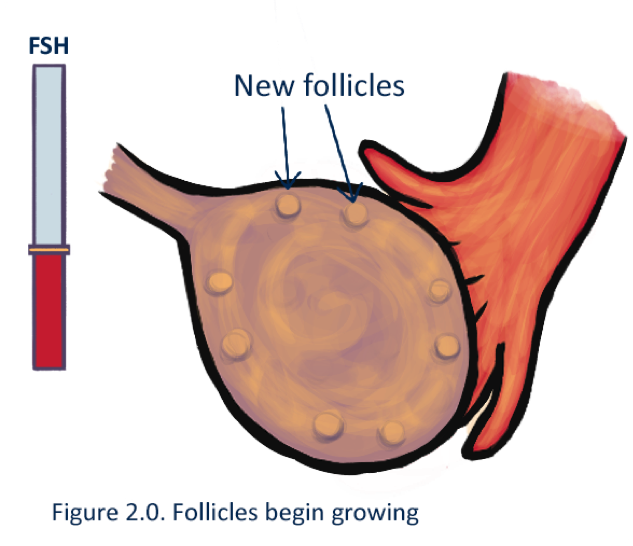
The growth of the follicles is stimulated bya hormone called follicle-stimulating hormone (FSH), which comesfrom a small gland in your brain the pituitary gland. As thefollicles race for ovulation, they produce a hormone calledoestrogen. As they grow, oestrogen and FSH levels increase.

Eventually one follicle starts winning therace and becomes bigger than all the rest. It is called thedominant follicle.
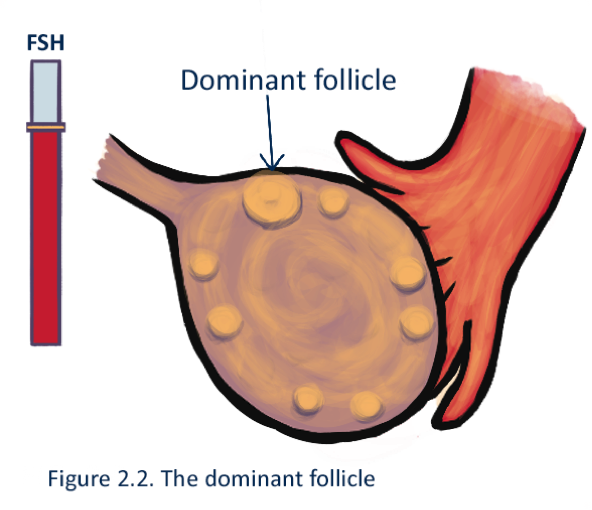
It gets really big while the other competingfollicles shrink away and are absorbed by the ovary.
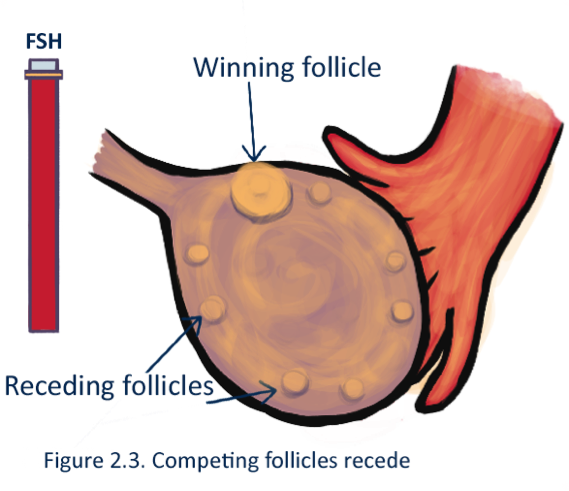
When the dominant follicle is nearly readyto pop out the egg, oestrogen levels get so high that they triggerthe pituitary gland to send out a different hormone luteinisinghormone (LH).
Next page
